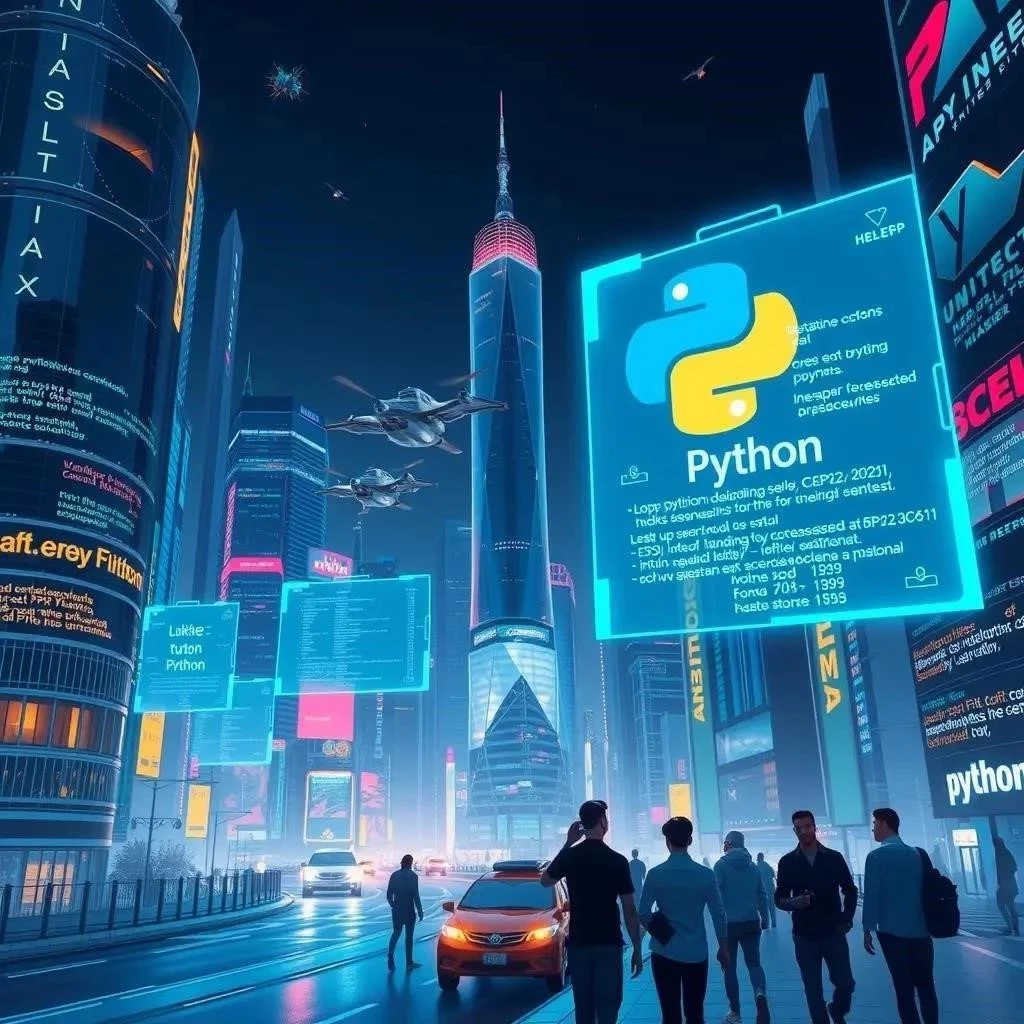
Why Learn Python in 2025: A Comprehensive Guide
In the ever-evolving landscape of programming languages, Python continues to stand out as a versatile and powerful tool. As we approach 2025, the reasons for learning Python are more compelling than ever before. From its beginner-friendly syntax to its extensive libraries and frameworks, Python empowers individuals to tackle a wide range of projects across various industries. This article will explore the key advantages of learning Python in 2025, highlighting its relevance, applicability, and future potential.
The Enduring Popularity of Python
Python’s popularity stems from several key factors that make it an attractive option for both novice and experienced programmers.
- Easy to Learn: Python’s syntax is designed to be readable and intuitive, making it easier for beginners to grasp fundamental programming concepts.
- Large Community: A vast and active community provides ample support, resources, and libraries for Python developers.
- Versatile Applications: Python is used in a wide range of fields, including web development, data science, machine learning, and scripting.
Python’s Role in Data Science and Machine Learning
One of the most significant drivers of Python’s popularity is its dominance in the fields of data science and machine learning. Libraries like NumPy, Pandas, Scikit-learn, and TensorFlow provide powerful tools for data analysis, manipulation, and model building.
- Data Analysis: Python facilitates the exploration and cleaning of large datasets.
- Machine Learning Model Development: Python provides the necessary tools and frameworks to build and train sophisticated machine learning models.
- Data Visualization: Libraries like Matplotlib and Seaborn enable the creation of insightful visualizations to communicate data findings.
Python in Web Development
While Python is known for its data science capabilities, it also plays a significant role in web development. Frameworks like Django and Flask provide a robust foundation for building web applications of varying complexity.
Comparing Python Web Frameworks
| Feature | Django | Flask |
|---|---|---|
| Level of Abstraction | Full-stack, high-level | Microframework, low-level |
| Flexibility | Less flexible, opinionated | Highly flexible, unopinionated |
| Learning Curve | Steeper learning curve | Easier learning curve |
| Use Cases | Large, complex applications | Small to medium-sized applications, APIs |
Future Trends and Python’s Continued Relevance
As technology continues to evolve, Python is well-positioned to remain a relevant and valuable skill. Its adaptability and ongoing development ensure that it will continue to meet the demands of emerging technologies.
FAQ: Learning Python in 2025
Is Python still a good language to learn in 2025?
Yes, absolutely! Python’s versatility, large community, and extensive libraries make it a valuable skill for a wide range of applications.
What are the best resources for learning Python?
There are many excellent resources available, including online courses, tutorials, and documentation. Consider platforms like Coursera, Udemy, and the official Python documentation website.
What kind of jobs can I get with Python skills?
Python skills are in high demand for roles such as data scientist, machine learning engineer, web developer, and software engineer.
How long does it take to learn Python?
The time it takes to learn Python depends on your learning style and goals. However, with consistent effort, you can learn the basics in a few weeks and become proficient within a few months.
Python’s Ecosystem and Integration Capabilities
Beyond its core strengths, Python’s robust ecosystem and seamless integration capabilities further solidify its position as a leading programming language. The availability of numerous packages and modules facilitates interoperability with other technologies and platforms, enabling developers to construct complex and integrated solutions.
Integration with Cloud Platforms
Python enjoys extensive support from major cloud providers such as Amazon Web Services (AWS), Google Cloud Platform (GCP), and Microsoft Azure. This integration allows developers to leverage cloud-based resources and services, scaling applications efficiently and cost-effectively.
- AWS Lambda: Python can be used to write serverless functions on AWS Lambda, enabling event-driven computing.
- Google Cloud Functions: Similar to AWS Lambda, Google Cloud Functions supports Python for building serverless applications.
- Azure Functions: Microsoft Azure also offers Python support for its serverless computing platform, Azure Functions.
Automating Tasks with Python
Python’s scripting capabilities make it an ideal choice for automating repetitive tasks and streamlining workflows. Libraries like `os`, `shutil`, and `subprocess` provide powerful tools for interacting with the operating system and automating system administration tasks.
- File Management: Python can be used to automate tasks such as renaming, copying, and deleting files.
- System Monitoring: Python scripts can be written to monitor system performance and send alerts when specific thresholds are exceeded.
- Data Processing: Python can be used to automate data cleaning, transformation, and loading processes.
Addressing Potential Challenges
While Python offers numerous advantages, it is essential to acknowledge potential challenges and consider mitigation strategies. Performance limitations, particularly in CPU-bound tasks, can be addressed through optimization techniques or the utilization of alternative languages for specific modules.
Concurrency and Parallelism
Python’s Global Interpreter Lock (GIL) can limit the performance of multi-threaded applications. However, libraries like `multiprocessing` allow developers to leverage multiple cores for parallel processing, improving performance in computationally intensive tasks.
| Approach | Description | Advantages | Disadvantages |
|---|---|---|---|
| Threading | Using multiple threads within a single process. | Lightweight, shared memory space. | Limited by the GIL for CPU-bound tasks. |
| Multiprocessing | Using multiple processes, each with its own interpreter. | Bypasses the GIL, utilizes multiple cores effectively. | Higher overhead, inter-process communication required. |
| Asynchronous Programming | Using `asyncio` to write concurrent code that executes in a single thread. | Efficient for I/O-bound tasks, good for network applications. | Requires careful design, can be complex. |
FAQ: Learning Python in 2025 (Continued)
What are some advanced Python concepts I should learn?
Consider exploring topics such as decorators, generators, metaclasses, and asynchronous programming to enhance your Python skills.
How can I contribute to the Python community?
You can contribute by writing documentation, submitting bug reports, contributing code to open-source projects, or answering questions on online forums.
What are some emerging technologies where Python is used?
Python is increasingly used in areas such as edge computing, IoT (Internet of Things), and blockchain development.
Python’s Role in Data Science and Machine Learning
The ubiquity of Python in the realms of data science and machine learning is undeniable; Its extensive ecosystem of libraries, coupled with its intuitive syntax, renders it an indispensable tool for data analysis, predictive modeling, and algorithm development. The burgeoning demand for professionals proficient in these domains further underscores the strategic advantage of acquiring Python skills in the foreseeable future.
Essential Libraries for Data Science
Several Python libraries stand as cornerstones of the data science workflow, facilitating tasks ranging from data manipulation to advanced statistical analysis:
- NumPy: Provides foundational numerical computing capabilities, including support for arrays, matrices, and mathematical functions.
- Pandas: Offers robust data structures and tools for data analysis and manipulation, enabling efficient handling of structured data.
- Scikit-learn: A comprehensive machine learning library providing algorithms for classification, regression, clustering, and dimensionality reduction.
- Matplotlib and Seaborn: Visualization libraries enabling the creation of informative and aesthetically pleasing charts and graphs.
Python in Machine Learning Deployment
Beyond model development, Python plays a critical role in the deployment and operationalization of machine learning models. Frameworks such as TensorFlow and PyTorch provide tools for building and deploying models at scale, enabling the integration of machine learning into production environments.
- Model Serving: Python-based frameworks facilitate the deployment of models as APIs, allowing other applications to access and utilize the models’ predictions.
- Model Monitoring: Python scripts can be used to monitor model performance over time, detecting and addressing issues such as data drift and model degradation.
- Automated Retraining: Python can automate the process of retraining models with new data, ensuring that models remain accurate and up-to-date.
The Python Community and Ecosystem
A significant factor contributing to Python’s enduring popularity is its vibrant and supportive community. This expansive network of developers, researchers, and enthusiasts actively contribute to the language’s development, providing resources, libraries, and solutions to address a wide range of challenges.
Open Source Contributions
Python’s open-source nature fosters collaboration and innovation, enabling developers to contribute to the language’s evolution and expand its capabilities. Participation in open-source projects not only enhances individual skills but also strengthens the overall Python ecosystem.
| Contribution Type | Description | Benefits |
|---|---|---|
| Code Contributions | Developing new features, fixing bugs, and improving existing code. | Enhances the language’s functionality and stability. |
| Documentation | Writing and maintaining documentation to improve the language’s usability. | Makes the language more accessible to new users. |
| Community Support | Answering questions, providing guidance, and mentoring other developers. | Fosters a welcoming and supportive environment for Python users. |
Addressing the Skills Gap
Despite the widespread adoption of Python, a persistent skills gap exists, particularly in specialized areas such as data science and machine learning. Individuals who possess a deep understanding of Python and its associated libraries are highly sought after by organizations across various industries.
Strategies for Skill Enhancement
To bridge the skills gap and enhance career prospects, individuals should consider pursuing continuous learning opportunities and focusing on developing expertise in specific domains:
- Online Courses and Tutorials: Numerous online platforms offer comprehensive Python courses and tutorials, catering to learners of all levels.
- Practical Projects: Engaging in practical projects allows individuals to apply their knowledge and gain hands-on experience.
- Community Involvement: Participating in online forums, attending conferences, and contributing to open-source projects provides valuable learning and networking opportunities.
FAQ: Learning Python in 2025 (Further Considerations)
How important is it to understand the underlying principles of computer science when learning Python?
While not strictly necessary for basic usage, a solid foundation in computer science principles, such as data structures and algorithms, can significantly enhance your ability to write efficient and effective Python code.
What are some common pitfalls to avoid when learning Python?
Common pitfalls include neglecting proper code formatting, failing to understand data types, and not utilizing debugging tools effectively. Paying attention to these details can save time and prevent frustration.
Is Python suitable for developing large-scale enterprise applications?
Yes, Python is indeed suitable for developing large-scale enterprise applications. Its scalability, extensive libraries, and support for various architectural patterns make it a viable choice for complex projects.



